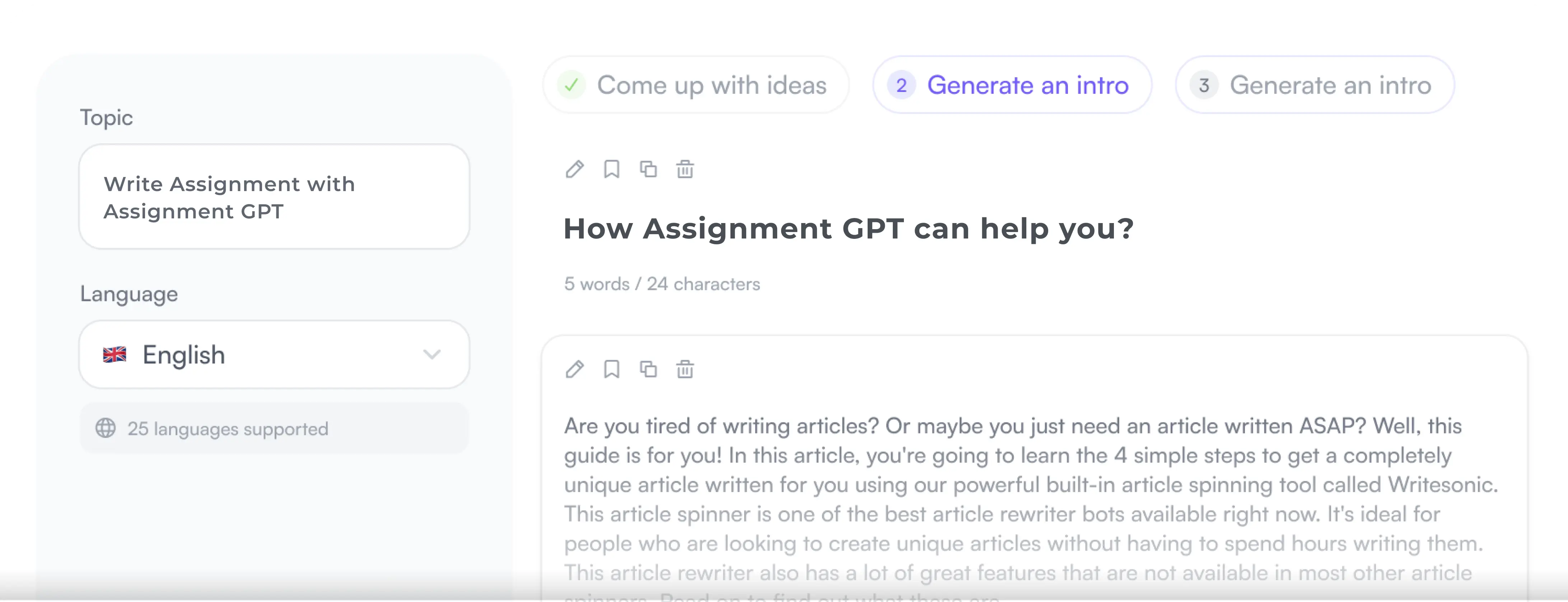AssignmentGPT Blogs
Kids and mathematics aren’t usually the best of buddies. Some kids excel at it naturally, while some need to put in extra time in order to understand the complexities of math.
But one thing that both natural and learned kids need is – practice. Without it, even the most gifted of minds would bow down to mathematics. Keeping all kids in mind, we’ve gathered a list of the most helpful tips that your child/children can use to get those straight A’s in mathematics!
Let’s start right away, aiding you in solving word problems!
Quick Summary
Let’s take a look at what we’ll be providing you with at a glance. Firstly, we’ll be breaking the problem step-by-step, tackling key steps like identifying information, translating words into math symbols, and using strategies like estimation and visualization.
We’ve got 9 super-duper tips for you that you can use hassle-free in solving math word problems, so let’s jump right into them!
Word Problems: A Step-by-Step Guide to Solving Them
Think of math problems as if you’re cracking a secret code, to which you don’t have the key to. But don’t worry, we’re here to help you out with that.
1. Analyze the problem by paraphrasing
The first step lies in truly grasping what the problem is asking. Read the problem a couple of times, pay attention to the formation of sentences and then attempt to explain it to yourself. This will help simplify the problem at hand.
Example:
Original Problem: John has 3 times as many marbles as Sarah. Together, they have 40 marbles. How many marbles does each person have?
Paraphrased Problem: We know John has a collection of marbles that's 3 times bigger than Sarah's. If we add all their marbles together, we get 40. Can you figure out how many marbles belong to each of them?
2. Identify Key Information and Variables
Next, start gathering various clues to solve the problem at hand. You’ll be looking for specific numbers, descriptions of quantities (twice as many, half as much etc). With that, you’ll also be looking for any unknown values represented by letters (variables). How do you solve word problems? Well, let us help!
Example:
In our example, key information includes:
- John has 3 times as many marbles as Sarah (this tells us the relationship between their quantities).
- Together, they have 40 marbles (this is the total amount).
- We don't know the exact number of marbles John or Sarah has individually (These are the unknowns represented by variables).
3. Translate Words into Mathematical Symbols
Now comes the magic! We translate the words describing quantities into mathematical symbols. Common translations include:
| English Word(s) | Mathematical Symbol |
|---|---|
| Is, Equals | < |
| More Than | > |
| Less Than | < |
| Times, Of | x |
| Divided By | / |
| Total, Sum (all elements added together) | Σ (sigma symbol) |
See how easy translating words to math can be? Check out AssignmentGPT AI Math Solver turning a word problem into clear equations in this demo.
Try it to simplify word problems for your kids.
Example:
- Problem: Alice has 2 more apples than Bob.
Translation:
- Let A represent the number of apples Alice has.
- "More than" translates to addition (+).
- Bob has an unknown number of apples, so let B represent that number.
- Therefore, the translation is: A = B + 2
4. Break Down the Problem into Manageable Parts
Large problems can feel overwhelming. Break them down into smaller, more manageable chunks. Identify sub-questions or steps that can lead you to the final solution. This helps loads in mathematical word problem solving.
This way, even the most complex of problems will feel like a walk in the park!
Example:
We can break down our problem into two parts: Find an expression for the total number of marbles John and Sarah have together. Use the relationship between their quantities (J = 3S) and the total number to find the individual values of J and S.
Also read this article : How to Learn Algebra
5. Draw Diagrams or Visual Representations
Sometimes, a picture is worth a thousand words. Don't hesitate to draw diagrams or use visual representations to help you see the relationships between quantities.
This will help in visualizing, in feeling the data that is provided to you.
Example:
We can draw two circles representing John's and Sarah's marbles. Label one circle "J" and the other "S."
Draw an arrow pointing to a larger circle labeled "Total: 40" to represent the combined amount.
This way, we can represent the data in a picturized manner.
6. Predict Answers using Estimation
Before diving into complex calculations, use estimation to get an idea of the answer. This can help you check your final solution later. This aids when you’re solving word problems with algebra.
This step uses the power of estimation, so that you can get a figure that’s just lingering somewhere around the right answer.
Example:
We know the total number of marbles is 40.
Since John has 3 times more than Sarah, we can estimate that John has around 3/4th of the total (because 3 is roughly 3/4th of 4) which is around 32 marbles.
This leaves roughly 10 marbles for Sarah.
7. Apply Logical Reasoning to Unknown Variables
Use your understanding of the relationships between quantities to solve for unknown variables. With logical reasoning, math problems are truly far easier to deal with.
Example:
We can substitute the equation J = 3S into the expression for the total number of marbles: (J + S) = 40 Since J = 3S, we can replace J with 3S: (3S + S) = 40
Combine like terms:
4S = 40
Divide both sides by 4 to isolate S:
S = 10 If Sarah has around 10 marbles, John must have around 30. So, let's assume Sarah has 10 marbles.
8. Review Answers in the Context of the Problem
Always check your answer! Substitute your findings back into the original problem and see if they hold true. This step usually tends to act as a safeguard, and can save you in the case of the smallest of miscalculations.
Example:
If John has 3 times as many marbles as Sarah (who has 10), then John has 3 * 10 = 30 marbles. Together, they would have 30 + 10 = 40 marbles. This matches the equation, and serves to tell us that it all worked out in the end.
9. Reflect and Learn from Mistakes
Mistakes are valuable learning opportunities! Analyze where you went wrong. Did you misread a number? Did you misunderstand a relationship?
Use this experience to improve your problem-solving skills for the next challenge. Never be afraid to make mistakes, only then can you learn and aim to better yourself.
Problem: A recipe calls for 3 cups of flour for every 2 eggs. If Sarah uses 12 eggs, how many cups of flour does she need?
Solution:
We might arrive at the answer: 18 (12 eggs * 3 cups/egg).
Reviewing in Context:
This answer seems reasonable at first glance. However, when we review the problem in context, it doesn't make sense. It would be unusual for a recipe to require more flour than eggs.
Corrected Solution:
We might realize the intended relationship is 2 cups of flour for every 3 eggs (not the other way around).
With 12 eggs, Sarah would need 12 eggs / 3 eggs/cup = 4 cups of flour.
Conclusion
By mastering these strategies, you'll transform from a word problem worrier to a confident math warrior! Solving word problems will then become a walk in the park!
Remember, practice is key. The more you tackle word problems, the more comfortable you'll become with deciphering their hidden messages. So, grab your pencil, ready your inner detective, and get ready to conquer the world of solving math word problems!
Stuck somewhere and need some expert help with your math work? AssignmentGPT AI Math Solver is there to help you out!
FAQs
1. What if I get stuck on a word problem and can't translate it into math symbols?
2. Is there a specific order I need to follow when solving word problems?
3. What if my answer doesn't seem to make sense?
Content writer at @AssignmentGPT
Kandarp’s world is powered by conversations, content, and creativity. With experience across branding, literature, publishing, and strategy, he has helped shape identities and stories for businesses across industries. At AssignmentGPT AI, he leads a team that blends sharp content, strong design, and local insight to turn businesses into brands that connect with people.
Master AI with
AssignmentGPT!
Get exclusive access to insider AI stories, tips and tricks. Sign up to the newsletter and be in the know!

Transform Your Studies with the Power of AssignmentGPT
Empower your academic pursuits with tools to enhance your learning speed and optimize your productivity, enabling you to excel in your studies with greater ease.
Start Your Free Trial ➤Start your success story with Assignment GPT! 🌟 Let's soar! 🚀
Step into the future of writing with our AI-powered platform. Start your free trial today and revolutionize your productivity, saving over 20 hours weekly.
Try For FREE ➤








